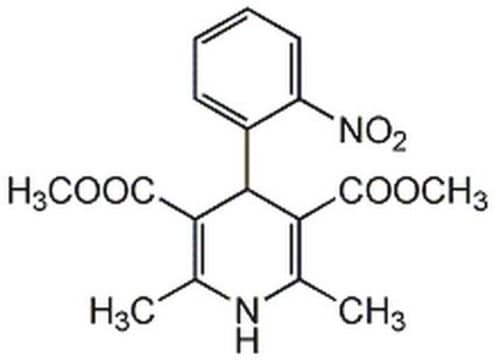P4670
Propafenone hydrochloride
Sinónimos:
1-[2-(2-Hydroxy-3-(propylamino)propoxy)phenyl]-3-phenyl-1-propanone hydrochloride
Seleccione un Tamaño
225,00 €
Seleccione un Tamaño
About This Item
225,00 €
Productos recomendados
Formulario
powder
emisor
Abbott
temp. de almacenamiento
2-8°C
cadena SMILES
Cl[H].CCCNCC(O)COc1ccccc1C(=O)CCc2ccccc2
InChI
1S/C21H27NO3.ClH/c1-2-14-22-15-18(23)16-25-21-11-7-6-10-19(21)20(24)13-12-17-8-4-3-5-9-17;/h3-11,18,22-23H,2,12-16H2,1H3;1H
Clave InChI
XWIHRGFIPXWGEF-UHFFFAOYSA-N
Información sobre el gen
human ... ABCB1(5243) , ADRB1(153) , ADRB2(154) , ADRB3(155) , CYP1A2(1544) , SCN10A(6336) , SCN11A(11280) , SCN1A(6323) , SCN2A(6326) , SCN3A(6328) , SCN4A(6329) , SCN5A(6331) , SCN7A(6332) , SCN8A(6334) , SCN9A(6335)
¿Está buscando productos similares? Visita Guía de comparación de productos
Descripción general
Aplicación
Acciones bioquímicas o fisiológicas
Características y beneficios
Palabra de señalización
Warning
Frases de peligro
Consejos de prudencia
Clasificaciones de peligro
Acute Tox. 4 Oral
Código de clase de almacenamiento
11 - Combustible Solids
Clase de riesgo para el agua (WGK)
WGK 3
Elija entre una de las versiones más recientes:
¿Ya tiene este producto?
Encuentre la documentación para los productos que ha comprado recientemente en la Biblioteca de documentos.
Filtros activos
Nuestro equipo de científicos tiene experiencia en todas las áreas de investigación: Ciencias de la vida, Ciencia de los materiales, Síntesis química, Cromatografía, Analítica y muchas otras.
Póngase en contacto con el Servicio técnico









